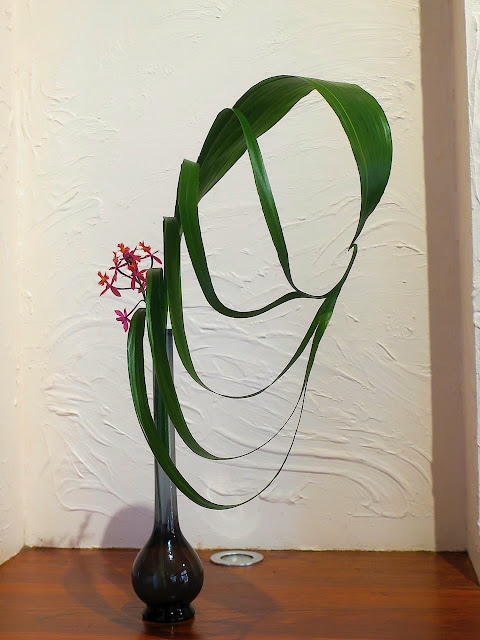Over the last several days we have had extremely windy weather. Being on the south coast we are subject to prevailing westerly winds, particularly in the winter months. However, the last few days have been unusually windy across Victoria.
...the arc became a full end-to-end rainbow. No evidence of pots of gold, just a beautiful sight produced by the afternoon sun behind us.
Meanwhile, a couple of weeks ago in fact, Maree practised using a vertical fixture to stabilise her quite horizontal branch of Monterey pine Pinus radiata. This is a technique for a nageire arrangement, that is: an ikebana made in a tall, usually straight sided, vase.
This technique is particularly useful when the weight of a branch causes it to rotate away from the desired angle. In this particular arrangement the Hikae line, projecting forward on the right, is made using branch material instead of flowers. The flowers have been placed in the centre of the ikebana, creating a central mass that visually holds the work together.
I had set the advanced students the exercise of making an ikebana arrangement with both straight and curving lines.
Because it was very dry, the curving branch could not be inserted into the kenzan.
The solution to this problem is to insert stems of fresh material on either side of the dried stem, to which it is wired. The small stem on the right in the kenzan is maintaining the desired angle of the main branch.
Ellie used a straight, but naturally-kinked line of bamboo. Her curving lines are of finely shredded New Zealand Flax Phormium, which creates a soft mass.
* * * * *
In the garden the Crucifix orchid Epidendrum radicans is finally in the right place and is doing well. I decided to use it as the focus in a simple ikebana.
Long ago, in my pre-ikebana days, I bought this tall grey-glass specimen vase, which continues to be useful for single flowers. On this occasion I first placed a partially shredded Aspidistra leaf finding the best angle to show the graceful lines. The leaf leans toward the front and the shredded section falls in looping curves. The orchid inflorescence is placed at the rear.
In retrospect, I think I should have used two stems of the flowers to make the mass bigger.
Greetings from Christopher
1st September 2024
1st September 2024











No comments:
Post a Comment